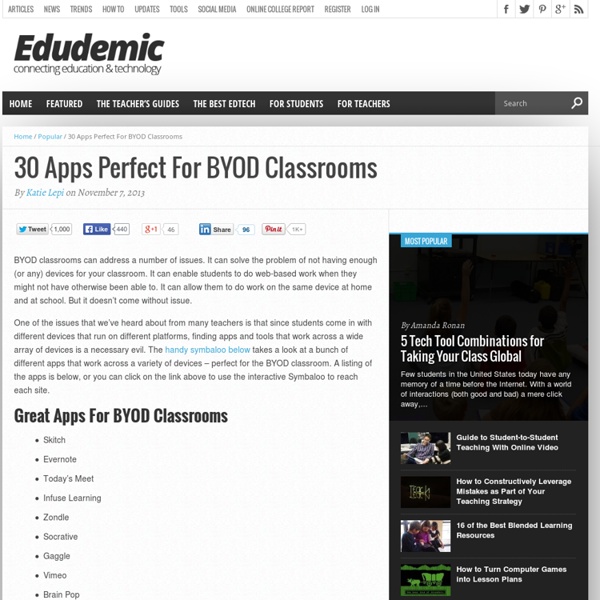Digitale Didactiek
A Student-Centered Universal BYOT Policy Template For Schools
A Student-Centered Universal BYOT Policy Template For Schools BYOT–which stands for Bring Your Own Technology–is a natural response to need for progressive learning tools in the 21st century classroom. There are a variety of factors that contribute here, including the rapid growth of technology, planned obsolescence on behalf of the technology manufacturers, the cost of technology, the ubiquity of technology in the lives of many learners, and, on a larger scale, the continued explosion of age of information itself. But it’s not without its challenges. While BYOT (or its twin, BYOD) can’t provide all of the answers–and creates challenges of its own, if your school or district is looking into BYOT, we thought it might be helpful to create a vague, universal BYOT policy and supporting framework that you could then modify to meet your specific needs. And to take it a step further, we wrote it in student-friendly language, because, after all, that’s the primary audience, yes? 3 Notes 1. 2. 3.
Voor- en nadelen van BYOD in het onderwijs | Bring your own device
Geplaatst door Jan Stedehouder Op Pro|Con Lists staat een overzicht van wat gezien word als voor- en nadelen van het inzetten van BYOD binnen het onderwijs, waarbij leerlingen dus met hun eigen smartphones, tablets en laptops komen en deze binnen de les mogen gebruiken. De lijst is interessant genoeg om eens goed naar te kijken, maar daarna wil ik toch stilstaan bij een aantal gerelateerde vraagstukken die alles te maken hebben met het waarborgen van de toegankelijkheid van het onderwijs. Eerst maar eens het overzicht: De voor- en nadelen houden elkaar goed in evenwicht. Aan de pluskant staat de verwachting dat leerlingen beter gemotiveerd zullen zijn om vaker, beter en anders te leren met de techniek zij daarvoor kiezen. Vergroot BYOD de ongelijkheid binnen het onderwijs? Is BYOD eigenlijk wel mogelijk binnen onze onderwijsinstellingen? In de campagne Open Onderwijstoegang bepleiten we het waarborgen van platformonafhankelijke toegang tot leermiddelen.
How BYOD Programs Can Fuel Inquiry Learning
Digital Tools Erin Scott Launching a Bring Your Own Device program can be both exhilarating and scary. The opportunity to extend access to technology in the classroom and at home is enticing, but school districts can get hung up on important details like providing a strong network, making sure each child has a device, and questions around distraction. Of course, no one answer will work for all teachers or students, but one guiding principle that’s shown to work is for schools to focus on how mobile technology will help shift instruction to be more collaborative, learner-driven and inquiry-based. “Instead of this just being a technology initiative, it really is an instructional initiative, so all of us from different departments can get on the same page,” said Tim Clark, coordinator of instructional technology for Forsyth County Schools in Georgia. Forsyth started out by creating a learner profile, a set of criteria the school district wanted students to learn while in school. Related
The 6 hidden tricks for Bring-Your-Own-Device success
By Meris Stansbury, Associate Editor @eSN_Meris Read more by Meris Stansbury January 15th, 2014 What every school district needs to know–outside of devices–that will make BYOD implementation a success By now, most districts considering the implementation of BYOD know there’s a lot more to success than apps and devices. But how can districts accurately measure how much bandwidth is needed? How do you ensure the quality of student work outside of simply using an app? For Dr. The district, which has a Learner Profile to guide district policy and practice, places BYOD implementation in the ‘instructional initiative’ category, since it’s not just a ‘device initiative,’ noted Clark. With the mindset that BYOD would bring a complete shift to the district in both teaching and learning, Forsyth discovered these six crucial pieces to help solve the BYOD puzzle: (Next page: 6 keys to success for BYOD implementation)



